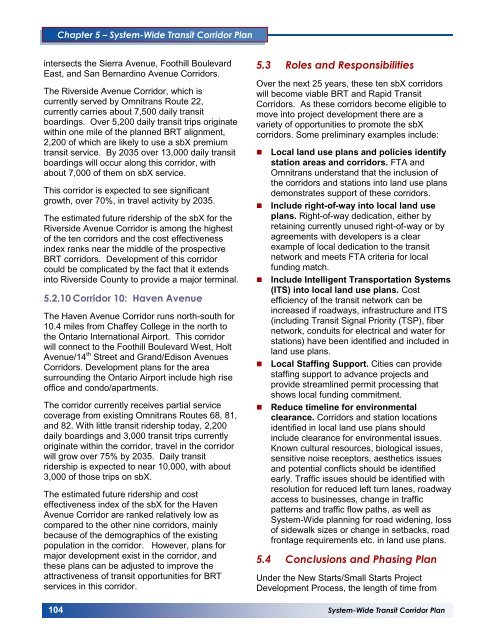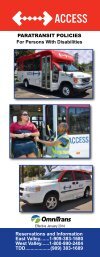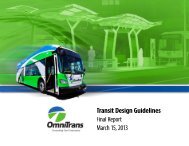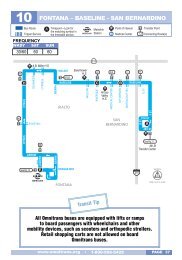New! System-Wide Transit Corridor Plan for the San ... - Omnitrans
New! System-Wide Transit Corridor Plan for the San ... - Omnitrans
New! System-Wide Transit Corridor Plan for the San ... - Omnitrans
Create successful ePaper yourself
Turn your PDF publications into a flip-book with our unique Google optimized e-Paper software.
Chapter 5 – <strong>System</strong>-<strong>Wide</strong> <strong>Transit</strong> <strong>Corridor</strong> <strong>Plan</strong><br />
intersects <strong>the</strong> Sierra Avenue, Foothill Boulevard<br />
East, and <strong>San</strong> Bernardino Avenue <strong>Corridor</strong>s.<br />
The Riverside Avenue <strong>Corridor</strong>, which is<br />
currently served by <strong>Omnitrans</strong> Route 22,<br />
currently carries about 7,500 daily transit<br />
boardings. Over 5,200 daily transit trips originate<br />
within one mile of <strong>the</strong> planned BRT alignment,<br />
2,200 of which are likely to use a sbX premium<br />
transit service. By 2035 over 13,000 daily transit<br />
boardings will occur along this corridor, with<br />
about 7,000 of <strong>the</strong>m on sbX service.<br />
This corridor is expected to see significant<br />
growth, over 70%, in travel activity by 2035.<br />
The estimated future ridership of <strong>the</strong> sbX <strong>for</strong> <strong>the</strong><br />
Riverside Avenue <strong>Corridor</strong> is among <strong>the</strong> highest<br />
of <strong>the</strong> ten corridors and <strong>the</strong> cost effectiveness<br />
index ranks near <strong>the</strong> middle of <strong>the</strong> prospective<br />
BRT corridors. Development of this corridor<br />
could be complicated by <strong>the</strong> fact that it extends<br />
into Riverside County to provide a major terminal.<br />
5.2.10 <strong>Corridor</strong> 10: Haven Avenue<br />
The Haven Avenue <strong>Corridor</strong> runs north-south <strong>for</strong><br />
10.4 miles from Chaffey College in <strong>the</strong> north to<br />
<strong>the</strong> Ontario International Airport. This corridor<br />
will connect to <strong>the</strong> Foothill Boulevard West, Holt<br />
Avenue/14 th Street and Grand/Edison Avenues<br />
<strong>Corridor</strong>s. Development plans <strong>for</strong> <strong>the</strong> area<br />
surrounding <strong>the</strong> Ontario Airport include high rise<br />
office and condo/apartments.<br />
The corridor currently receives partial service<br />
coverage from existing <strong>Omnitrans</strong> Routes 68, 81,<br />
and 82. With little transit ridership today, 2,200<br />
daily boardings and 3,000 transit trips currently<br />
originate within <strong>the</strong> corridor, travel in <strong>the</strong> corridor<br />
will grow over 75% by 2035. Daily transit<br />
ridership is expected to near 10,000, with about<br />
3,000 of those trips on sbX.<br />
The estimated future ridership and cost<br />
effectiveness index of <strong>the</strong> sbX <strong>for</strong> <strong>the</strong> Haven<br />
Avenue <strong>Corridor</strong> are ranked relatively low as<br />
compared to <strong>the</strong> o<strong>the</strong>r nine corridors, mainly<br />
because of <strong>the</strong> demographics of <strong>the</strong> existing<br />
population in <strong>the</strong> corridor. However, plans <strong>for</strong><br />
major development exist in <strong>the</strong> corridor, and<br />
<strong>the</strong>se plans can be adjusted to improve <strong>the</strong><br />
attractiveness of transit opportunities <strong>for</strong> BRT<br />
services in this corridor.<br />
5.3 Roles and Responsibilities<br />
Over <strong>the</strong> next 25 years, <strong>the</strong>se ten sbX corridors<br />
will become viable BRT and Rapid <strong>Transit</strong><br />
<strong>Corridor</strong>s. As <strong>the</strong>se corridors become eligible to<br />
move into project development <strong>the</strong>re are a<br />
variety of opportunities to promote <strong>the</strong> sbX<br />
corridors. Some preliminary examples include:<br />
• Local land use plans and policies identify<br />
station areas and corridors. FTA and<br />
<strong>Omnitrans</strong> understand that <strong>the</strong> inclusion of<br />
<strong>the</strong> corridors and stations into land use plans<br />
demonstrates support of <strong>the</strong>se corridors.<br />
• Include right-of-way into local land use<br />
plans. Right-of-way dedication, ei<strong>the</strong>r by<br />
retaining currently unused right-of-way or by<br />
agreements with developers is a clear<br />
example of local dedication to <strong>the</strong> transit<br />
network and meets FTA criteria <strong>for</strong> local<br />
funding match.<br />
• Include Intelligent Transportation <strong>System</strong>s<br />
(ITS) into local land use plans. Cost<br />
efficiency of <strong>the</strong> transit network can be<br />
increased if roadways, infrastructure and ITS<br />
(including <strong>Transit</strong> Signal Priority (TSP), fiber<br />
network, conduits <strong>for</strong> electrical and water <strong>for</strong><br />
stations) have been identified and included in<br />
land use plans.<br />
• Local Staffing Support. Cities can provide<br />
staffing support to advance projects and<br />
provide streamlined permit processing that<br />
shows local funding commitment.<br />
• Reduce timeline <strong>for</strong> environmental<br />
clearance. <strong>Corridor</strong>s and station locations<br />
identified in local land use plans should<br />
include clearance <strong>for</strong> environmental issues.<br />
Known cultural resources, biological issues,<br />
sensitive noise receptors, aes<strong>the</strong>tics issues<br />
and potential conflicts should be identified<br />
early. Traffic issues should be identified with<br />
resolution <strong>for</strong> reduced left turn lanes, roadway<br />
access to businesses, change in traffic<br />
patterns and traffic flow paths, as well as<br />
<strong>System</strong>-<strong>Wide</strong> planning <strong>for</strong> road widening, loss<br />
of sidewalk sizes or change in setbacks, road<br />
frontage requirements etc. in land use plans.<br />
5.4 Conclusions and Phasing <strong>Plan</strong><br />
Under <strong>the</strong> <strong>New</strong> Starts/Small Starts Project<br />
Development Process, <strong>the</strong> length of time from<br />
132 104 <strong>System</strong>-<strong>Wide</strong> <strong>Transit</strong> <strong>Corridor</strong> <strong>Plan</strong>














